The quotes along the terrace steps reflect the different attitudes during World War I.
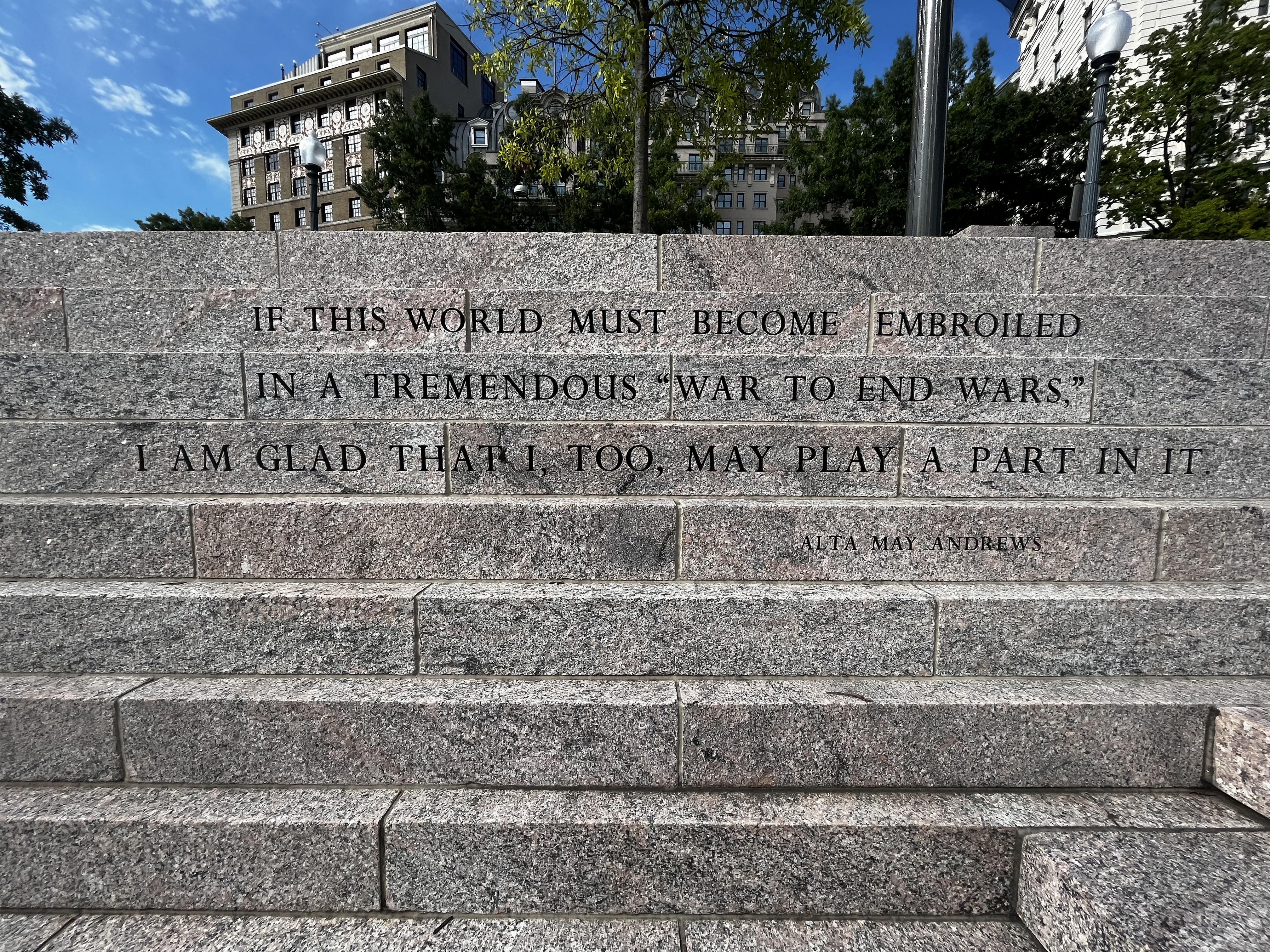
- A quote on stone steps leading up to a park .
John Pershing (1860-1848) was commander of US forces in World War I. In 1919 he was awarded the rank "General of the Armies," the highest rank possible in the US military, which was created specially for him.
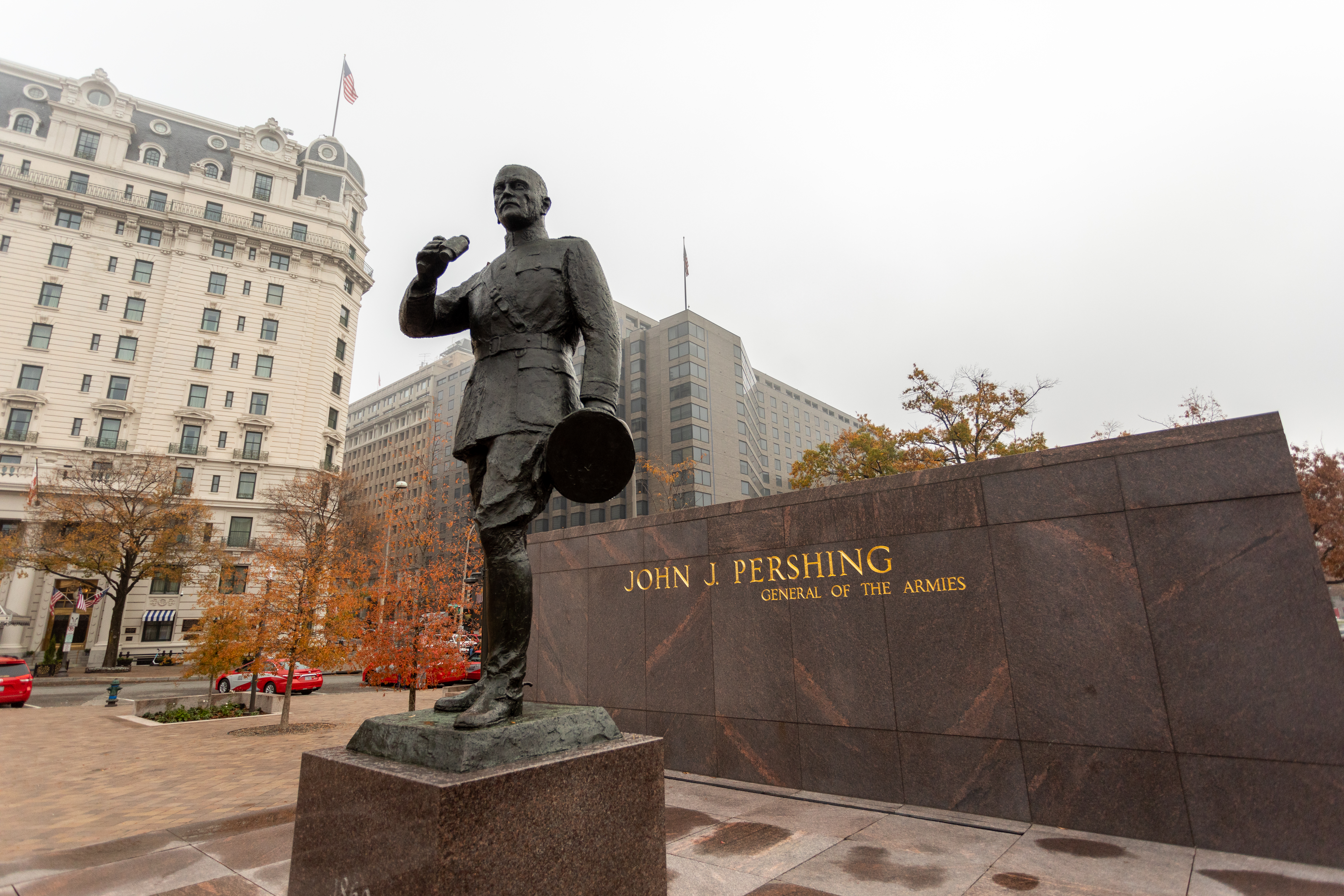
- (331 words)<br />The General John J. Pershing Memorial is located at the east side of Pershing Park, bordered by 14th street NW to the east, Pennsylvania Avenue to the north and E street to the south. The Willard Hotel sits across the street on the north side of Pennsylvania Avenue.<br />A grass hill borders the east side of the memorial, and access is provided along Pennsylvania Avenue on the north side and a staircase that leads up from the southeast corner at E and 14th streets.<br />The Pershing statue sits in a fifty-two-foot by seventy-five-foot granite plaza, bordered by two ten-foot high dark granite walls lining the east and south sides.<br />The east side wall measures thirty-feet long and three-feet thick. A gold inscription across its outer, east-facing side reads:<br />IN THEIR DEVOTION THEIR VALOR AND IN THE LOYALFULFILLMENT OF THEIR OBLIGATIONS THE OFFICERS AND MEN OF THE AMERICAN EXPEDITIONARY FORCES HAVE LEFT A HERITAGE OF WHOCH THOSE WHO FOLLOW MAY EVER BE PROUD.<br />John J. Pershing (signature)<br />An inscription on the interior side of the wall reads:<br />JOHN J. PERSHING<br />GENERAL OF THE ARMIES<br />The bronze statue stands about eight feet tall. Pershing faces west, in military uniform with boots and belt around his waist, holding binoculars at his chest with his right hand and holding his hat in his left hand at his side.<br />An inscription on the face of the three-foot tall granite pedestal beneath him reads:<br />1860<br />1948<br />A twenty-foot long granite bench sits about twenty feet in front of the statue, to the west.<br />The south side wall features text panels describing the vital contributions of American forces toward winning and ending the Great War. See transcriptions in main content text. Two maps illustrate troop movements in the Western Front and the Meuse-Argonne Campaign.<br />Pershing Park covers a nearly two-acre trapezoid-shaped landscape. West of the Pershing memorial is a forty-square-foot sunken plaza area lined with gardens and trees throughout.<br />END OF DESCRIPTION<br />
"A Soldier's Journey" depicts a series of scenes based on the myth of "the hero's journey," in which a recurring figure of an American soldier embarks on a quest, wins victory in an epic struggle, and comes home changed by his passage through peril. The soldier also represents, on a second level, the American experience of World War I. This illustration shows the artistic process from initial sketch, to clay sculpture, to finished bronze.
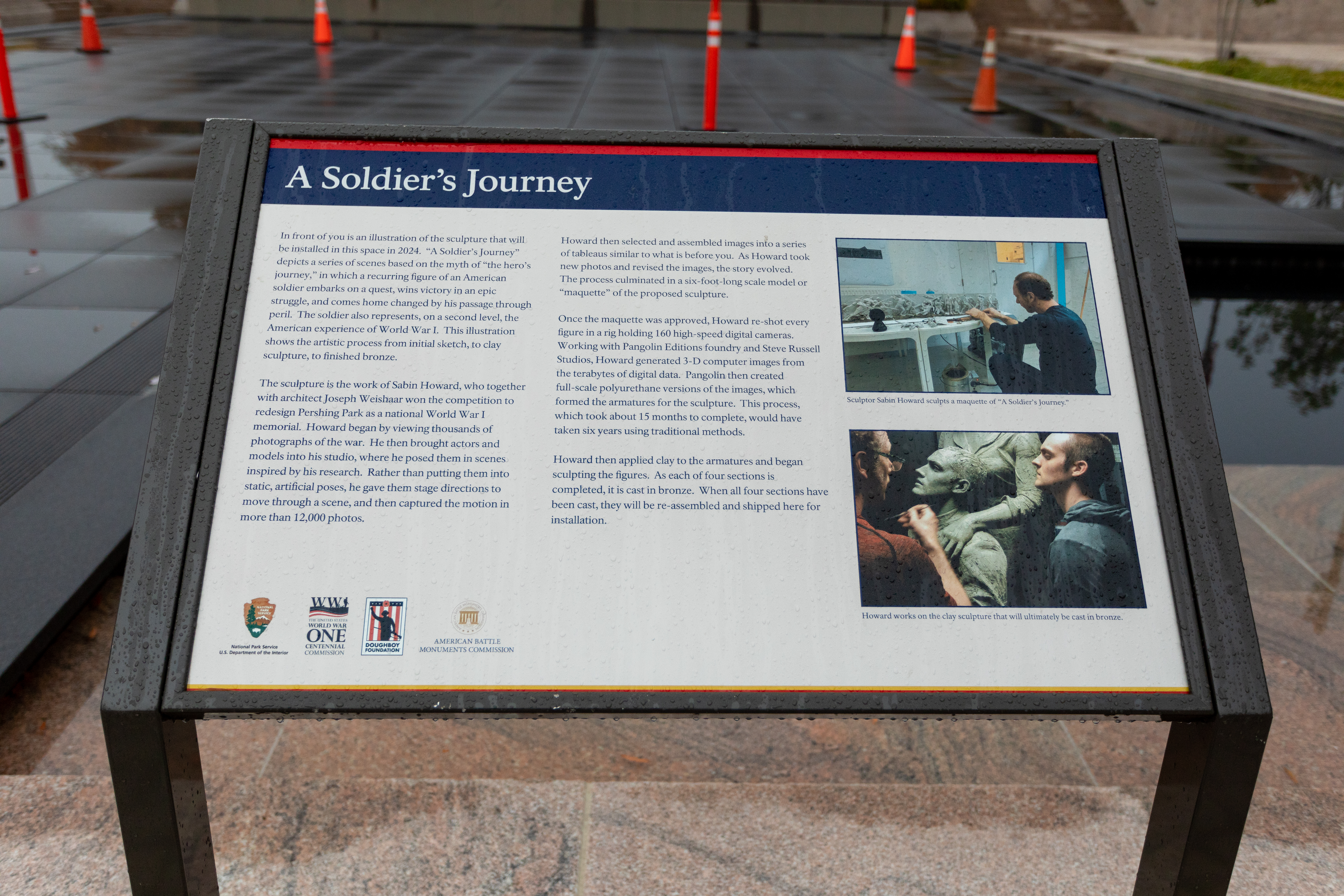
- An angled information panel stands in front of a pool of water and a rectangular plaza structure. Photographs show a sculptor working on a scale model of a processional of soldiers and creating a life-size sculpture of a male model.
The Pennsylvania Avenue Development Corporation dedicated Pershing Park in 1981. In the intervening years, planners had changed the purpose of the block from a memorial to a place for many activities. A tribute to the general, designed by Wallace Harrison, was included.
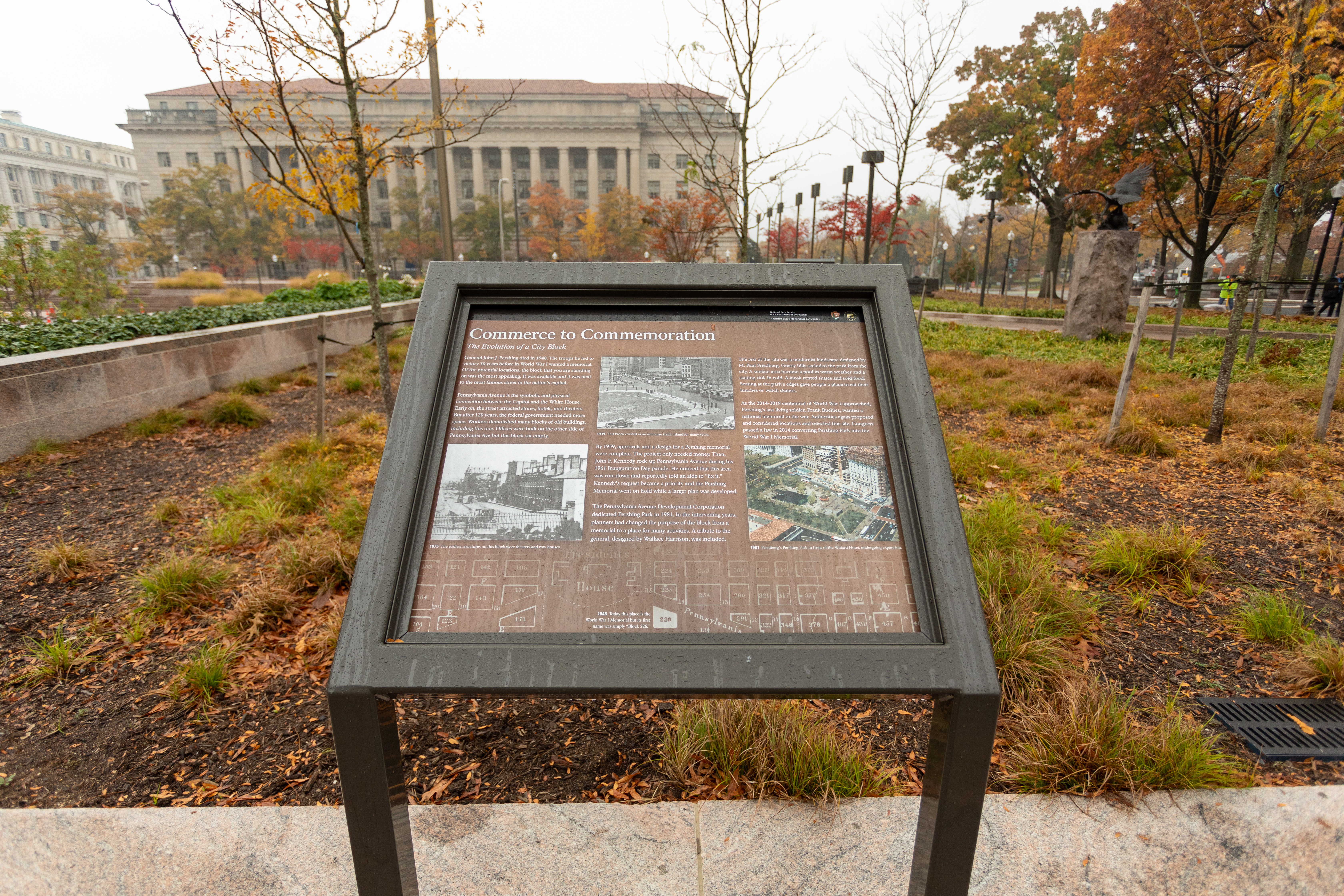
- An angled information panel along a stone curb at the edge of a planted garden of long grassy plants and small trees. A neoclassical building with tall columns stands in the background. Images show historic photographs of a city block with old-fashioned cars and an aerial view of the park with a rectangular pool in the center.
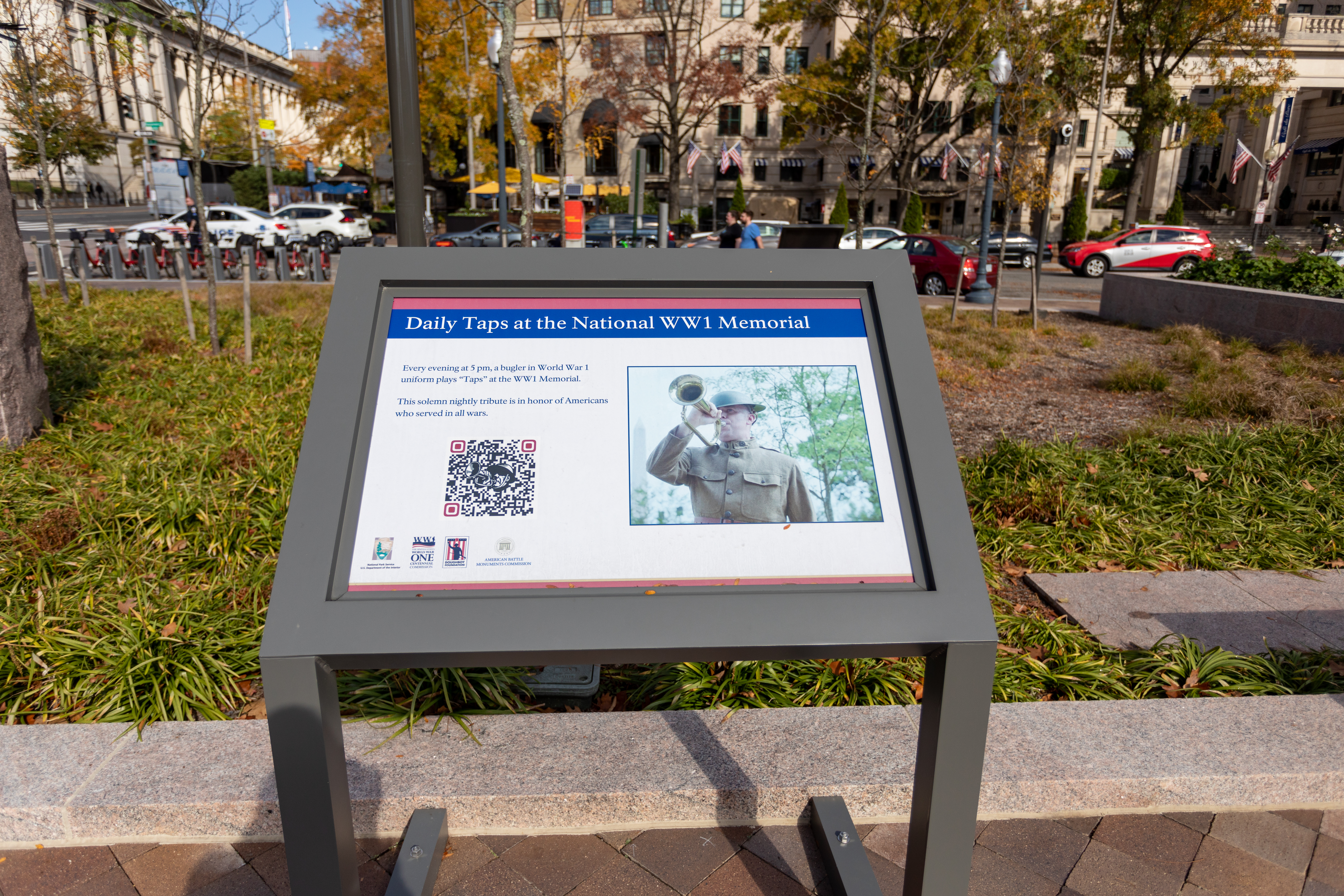
- An information panel adjacent to a planted area.
he maps engraved on the wall show a timeline of America’s involvement in World War I.
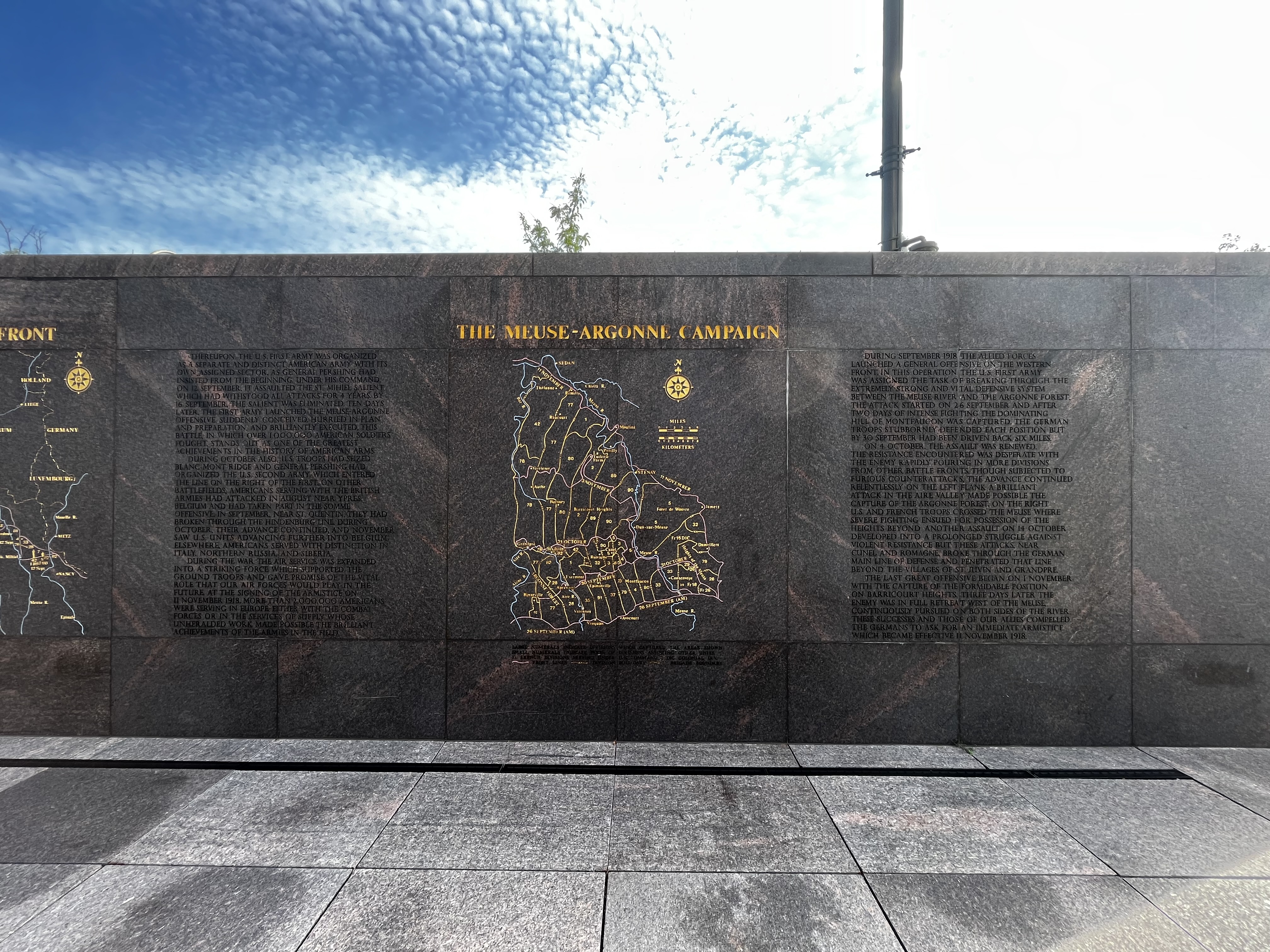
- A large, engraved map of intersecting lines.
The Peace Fountain stands along the western end of the Memorial. The fountain has words in raised letters by Archibald MacLeish, a poet, and Congressional Librarian.
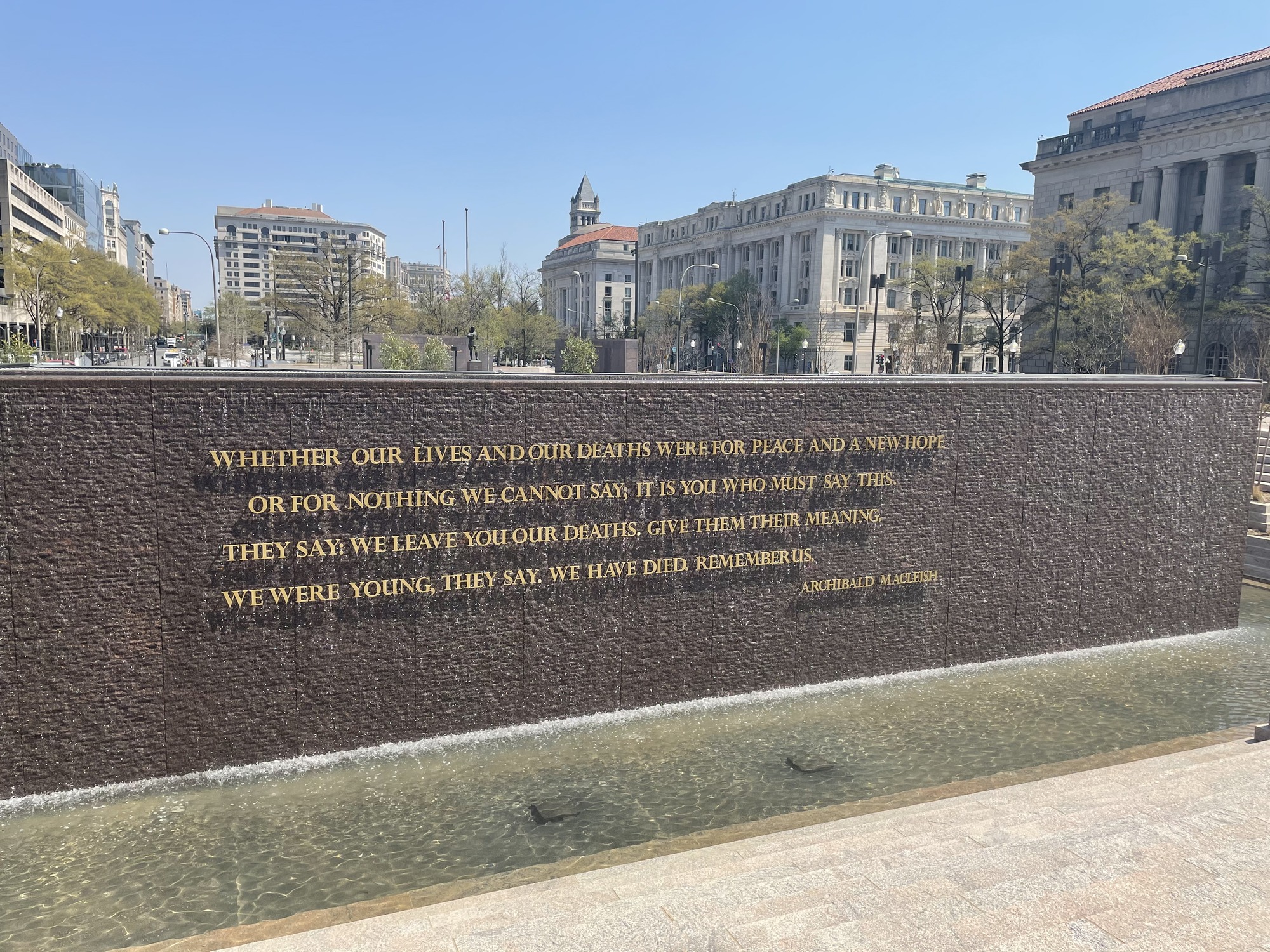
- A large stone structure with a
The belvedere, or lookout, holds stories that honor the different struggles, and ultimate triumphs, that marginalized groups faced during World War I.
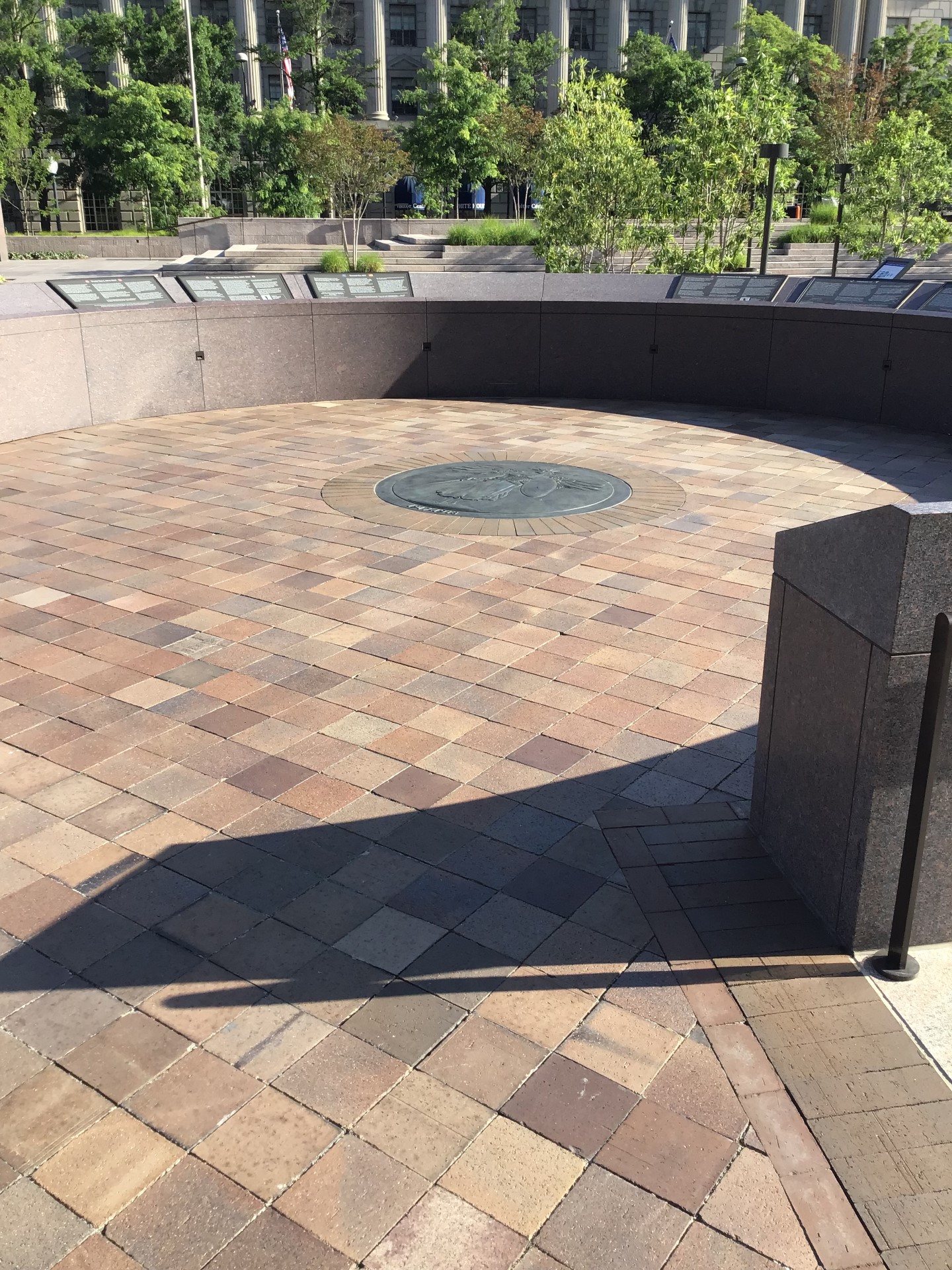
- A circular outdoor exhibit with a series of plaques depicting war stories from World War I. The exhibit is located in a park filled with trees.
The Bex Eagle, named after its commissioner Brian Bex, was dedicated in 1982. It was sculpted by Lorenzo Ghiglieri in 1980 and given to the National Park Service after its dedication. The eagle commemorates the bicentennial of the bird becoming America’s national symbol.

- A large bronze eagle statue holding the world in it's talons.
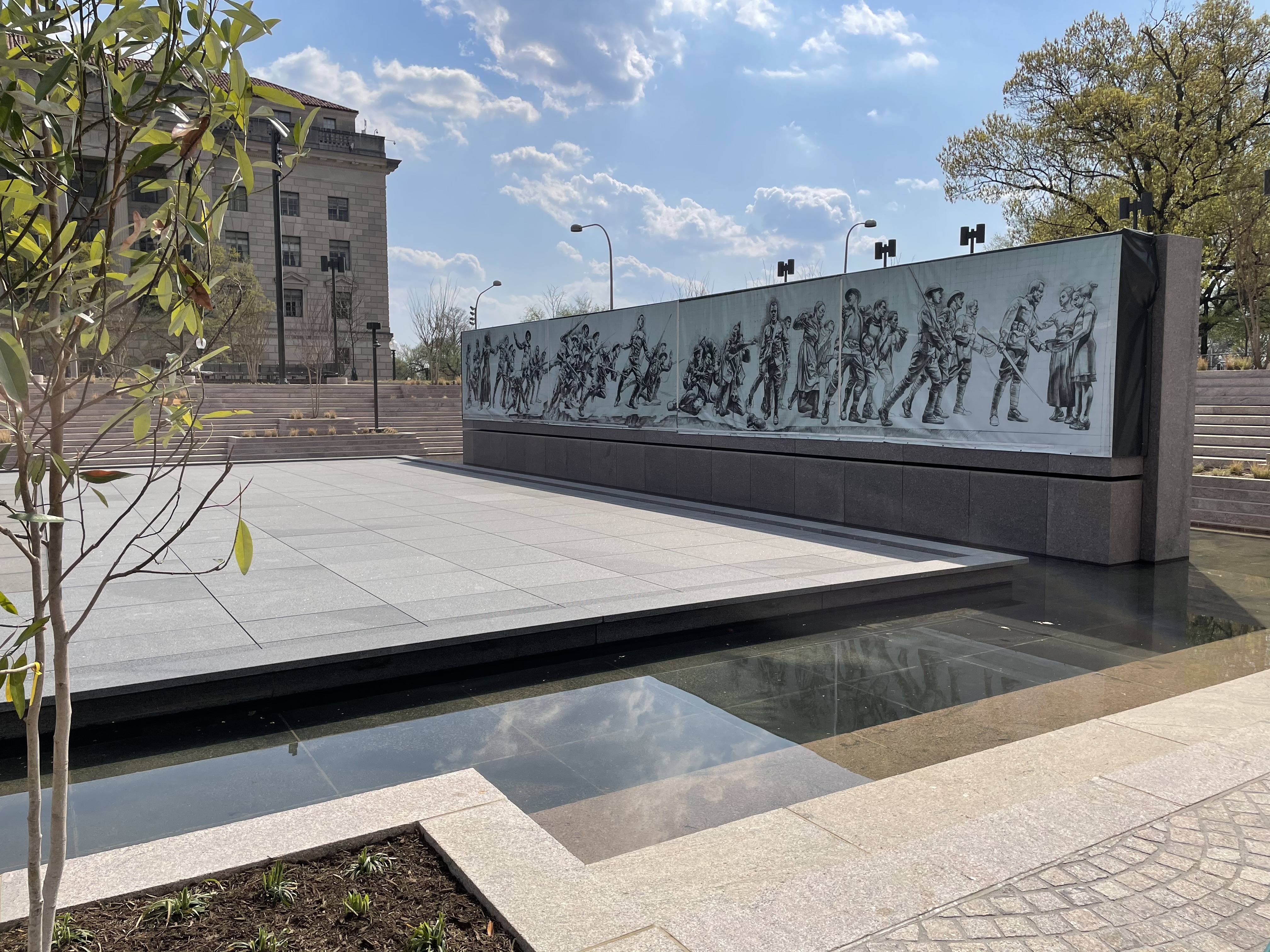
- (176 words) National World War I Memorial is located on the west side of Pershing Park, bordered by 15th street NW to the west, Pennsylvania Avenue to the north and E street to the south. The Willard Hotel sits across the street on the north side of Pennsylvania Avenue. Pershing Park covers a nearly two-acre trapezoid-shaped landscape. The General John J. Pershing Memorial sits at the east end of the park among two pink granite walls of the American Expeditionary Forces Memorial. West of the Pershing memorial is a four-foot sunken plaza area lined with gardens and trees throughout, providing a peaceful setting amongst the busy streets that form the borders of the park. A glass enclosed atrium sits in the center of the plaza. Sloped walkways lead into the park from the northwest and southwest corners. A grass hill borders the east side of the memorial and access is provided into the park on the north side along Pennsylvania Avenue and a staircase that leads up from the southeast corner at 14th and E streets. END OF DESCRIPTION
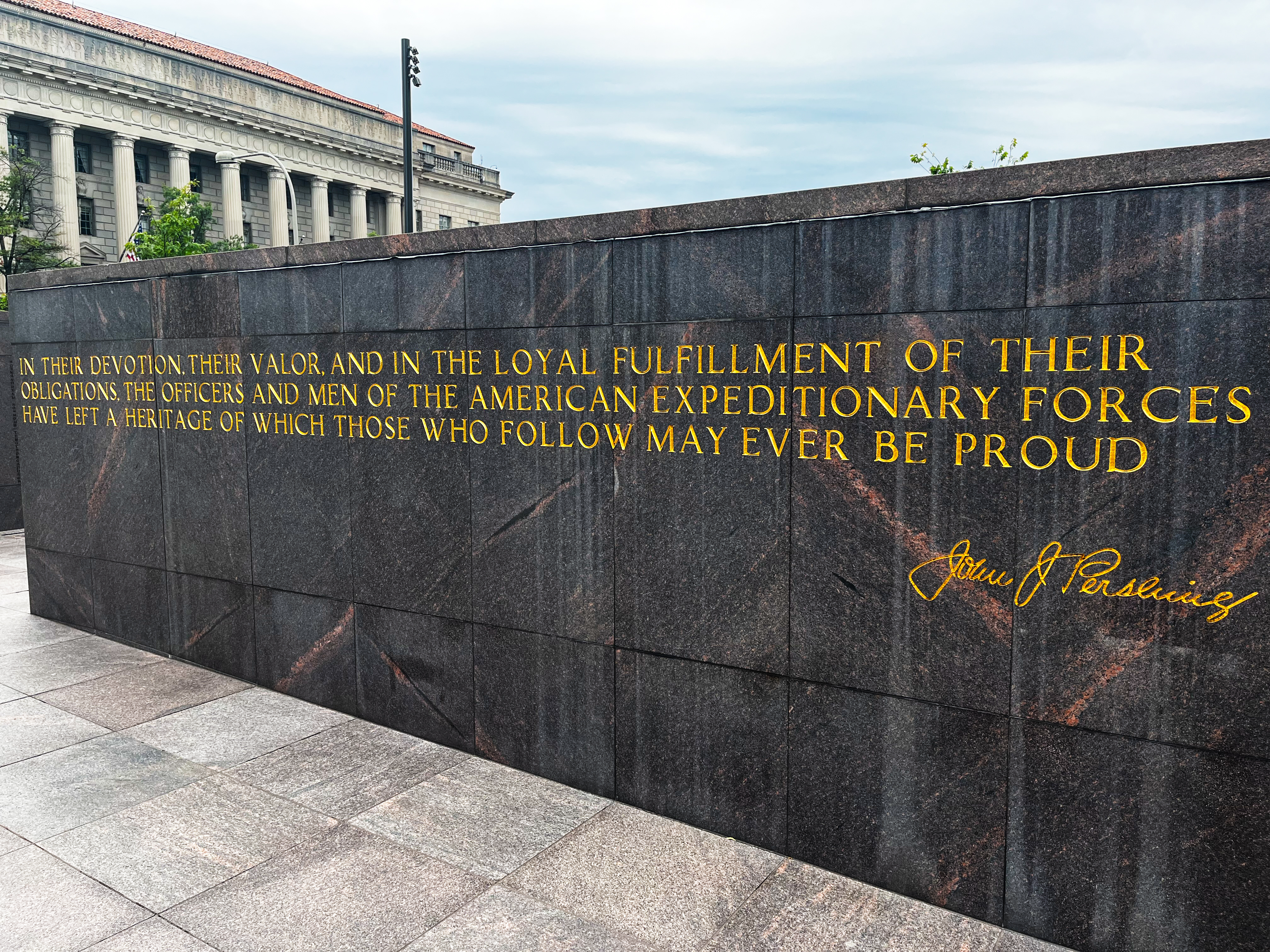
- A large wide stone structure with a quote in gold lettering. The quote reads "In their devotion, their valor, and in the loyal fulfillment of their obligations, The Officers and men of the American expeditionary forces have left a heritage of which those who follow may ever be proud. - John Pershing
"A Soldier’s Journey," by sculptor Sabin Howard, is the central feature of the World War I Memorial.
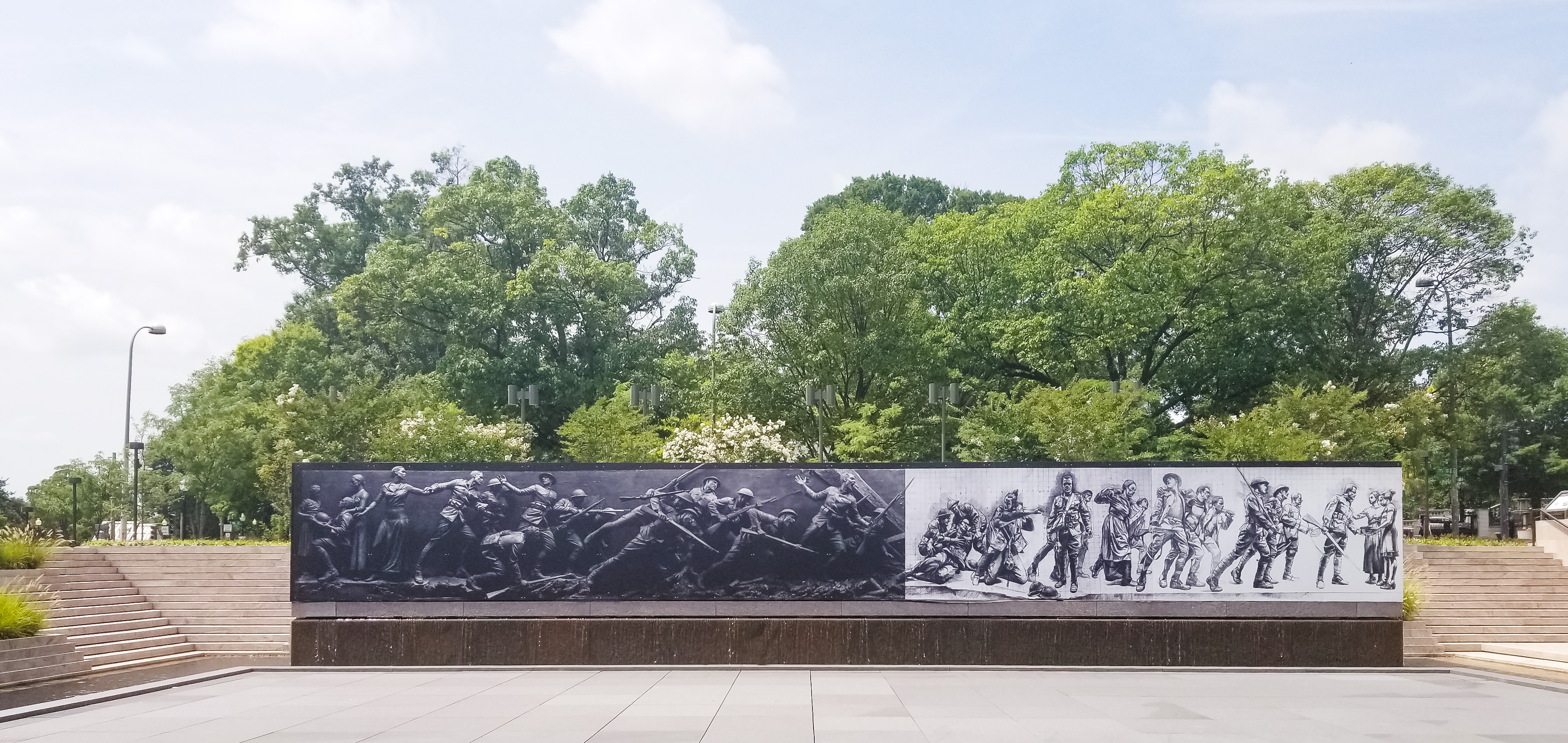
- A large mural of soldiers in battle. The right half of the mural is a bronze and depicts fighting in the war. The second half of the mural is a black and which sketch. The panel has thirty-eight separate figures, spread over approximately 58 feet of wall towards the western end of the Memorial Core, portray the experience of one American soldier. Starting from the left, the soldier takes leave from his wife and daughter, charges into combat, sees men around him killed, wounded, and gassed, and recovers from the shock to come home to his family. The figures are mounted on the wall. Behind the mural are various large trees.











